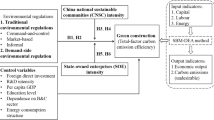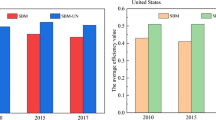Abstract
Achieving “Responsible Consumption and Production” is one of the 17 sustainable development goals set by the United Nations. Controlling overcapacity is an important guarantee in order to achieve this goal. There are many types and large quantities of raw materials in the construction industry, which easily leads to overcapacity. Studying the problems related to overcapacity in the construction industry helps to understand the formation mechanism of overcapacity in related industries. This puts forward targeted countermeasures and suggestions for the capacity resolution to achieve green and sustainable development. Based on this, this paper uses the construction industry capacity utilization data of the Shandong Province in China from 2005 to 2017. It also uses the production function method to construct a construction industry overcapacity calculation model to estimate the construction industry capacity utilization and overcapacity rate in Shandong Province. The DEA method was used to construct an extraction model of influencing factors for overcapacity. The results show that the capacity utilization ratio for Shandong Province from 2005 to 2016 was 81.98%. There was no overcapacity as a whole, but there were large fluctuations in capacity utilization for some time periods. Suggestions for optimization countermeasures were also proposed.



Similar content being viewed by others
Data Availability
The datasets used and/or analyzed during the current study are available from the corresponding author on reasonable request.
References
Aigner DJ, Chu SF (1968) On estimating the industry production function. Am Econ Rev 58(4):826–839
Chamberlin EH (1949) Theory of monopolistic competition: a re-orientation of the theory of value. Oxford University, London
Corrado C, Mattey J (1997) Capacity utilization. J Econ Perspect 11:151–167
Fare R, Grosskopf S, Kokkelenberg E (1989) Measuring plant capacity, utilization and technical change: a nonparametric approach. Int Econ Rev 30(3):655–666
He L (2015) Research on the measurement of capacity utilization in China’s industrial industry: based on the method of panel co-integration. Ind Econ Res 2:90–99
He JT, He L (2016) State-owned enterprise expansion, credit distortion and overcapacity: an empirical study based on industry panel data. Contemp Econ Sci 38(1):58–67
Huang XZ, Zhao B (2019) Has excess capacity forced China’s industrial structure to upgrade? Comp Econ Soc Syst 2:18–29
Karagiannis R (2015) A system-of-equations two-stage DEA approach for explaining capacity utilization and technical efficiency. Ann Oper Res 227(1):25–43
Klein LR, Preston RS (1967) Some new results in the measurement of capacity utilization. Am Econ Rev 57(1):34–58
Li XW, Du JG, Long HY (2018) A comparative study of Chinese and foreign green development from the perspective of mapping knowledge domains. Sustainability 10:43–57
Lin YF, Wu HM, Xing YQ (2010) “Surge phenomenon” and the formation mechanism of excess capacity. Econ Res 10:4–19
Ouyang MK, Zhang YB (2018) Fiscal subsidies, distorted competition and overcapacity in the automotive industry. Financ Res 12:84–96+113
Qin LL (2017) Problem of overcapacity in china from the perspective of supply-side reform in the factor market and the solution path. Reform Strategy 33(2):2–45
Shaikh A, Moudud JK (2004) Measuring capacity utilization in OECD countries: a cointegration method. The Levy Economics Institute
Sun Z, Chen XD, Su XY (2019) Local competition, overcapacity and fiscal sustainability. Ind Econ Res 1:75–86
Tang W, Wu L, Zhang ZX (2010) Oil price shocks and their short-and long-term effects on the Chinese economy. Energy Econ 32:S3–S14
Wang Y, Luo G, Guo Y (2014) Why is there overcapacity in China’s PV industry in its early growth stage? Renew Energy 72:188–194
Wang D, Wan K, Song X (2018) Quota allocation of coal overcapacity reduction among provinces in China. Energy Policy 116:170–181
Xu YK, Ma GY (2019) Changes in local officials and enterprise overcapacity. Econ Res 54(5):129–145
Yu HJ, Han LM (2013) Structural overcapacity in marine strategic emerging industries: performance, causes and countermeasures. Theory J 3:67–71
Yu DH, Lu YN (2015) Improper government intervention and overcapacity in strategic emerging industries: taking China’s photovoltaic industry as an example. China Ind Econ 10:53–68
Zhang L (2016) A summary of research on China-style overcapacity. Econ Perspect 9:90–100
Zhang H, Zheng Y, Ozturk UA et al (2016) The impact of subsidies on overcapacity: a comparison of wind and solar energy companies in China. Energy 94:821–827
Zhao CW, Xu ZY, Yuan D, Liao B (2015) Research on the characteristics, risks and countermeasures of current overcapacity in china: analysis based on field investigation and micro data. Manag World 4:1–10
Acknowledgments
We are thankful for the suggestions and efforts from the experts and editors. The first two authors contributed equally to this work.
Funding
The paper was funded by the Youth Innovation Team Project of Central University of Finance and Economics (No. CUFE2019-012) and the First-class Discipline Construction Project of Central University of Finance and Economics (No.CUFE2018-006), the Social Sciences Project of the Ministry of Education (No. 20YJC790158), and the National Natural Science Foundation of China (No. 71810107004).
Author information
Authors and Affiliations
Contributions
Chunqing Jin, Ling Jiang, and Xuanting Ye conceived and designed the study. Qi Li, Ling Jiang, and Xuanting Ye performed the experiments. Qi Li, Ling Jiang, and Zaixu Zhang wrote the paper. Chunqing Jin, Ling Jiang, and Xuanting Ye reviewed and edited the manuscript. All authors read and approved the final manuscript.
Corresponding authors
Ethics declarations
Conflict of interests
The authors declare that they have no conflict of interest.
Ethics approval and consent to participate
Not applicable.
Consent for publication
Not applicable.
Additional information
Responsible Editor: Philippe Garrigues
Publisher’s note
Springer Nature remains neutral with regard to jurisdictional claims in published maps and institutional affiliations.
Rights and permissions
About this article
Cite this article
Jin, C., Li, Q., Jiang, L. et al. Measurement for overcapacity and its influencing factors on the construction industry—evidence from China’s provincial data. Environ Sci Pollut Res 28, 7883–7892 (2021). https://doi.org/10.1007/s11356-020-11045-y
Received:
Accepted:
Published:
Issue Date:
DOI: https://doi.org/10.1007/s11356-020-11045-y




